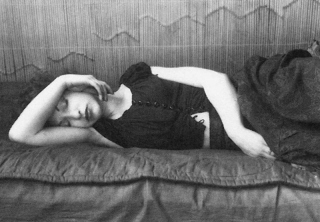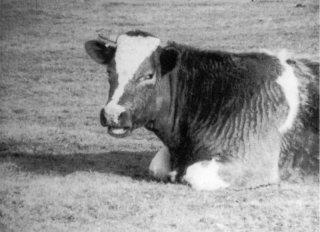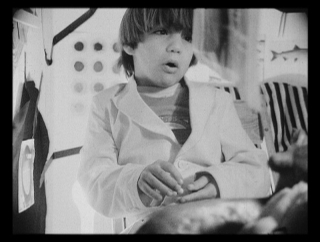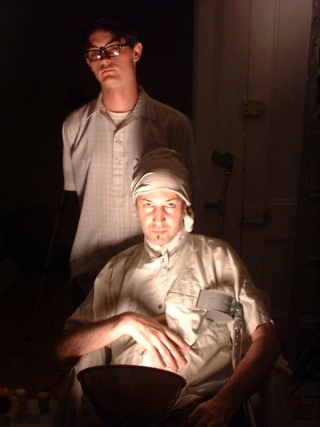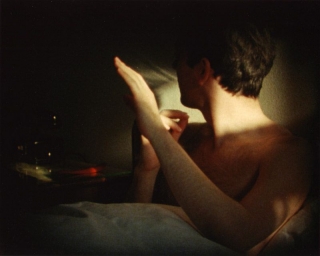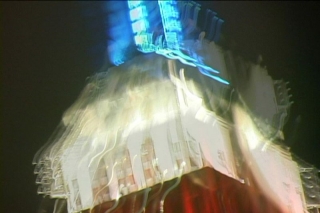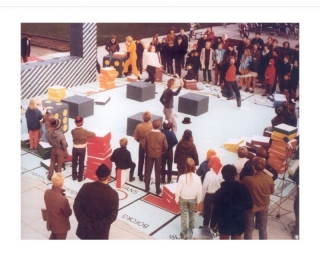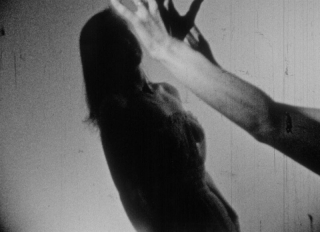Date: 13 November 2002 | Season: London Film Festival 2002 | Tags: London Film Festival
IN THE MIRROR OF MAYA DEREN
Wednesday 13 November 2002, at 8:45pm
London National Film Theatre NFT3
‘More than anything else, cinema consists of the eye for the magic – that which perceives and reveals the marvellous in whatsoever it looks upon.’ (Maya Deren)
Martina Kudlácek, In the Mirror of Maya Deren, Austria, 2001, 103 min
A feature length biography of the life and work of Maya Deren, whose Meshes of the Afternoon (1943) is widely regarded as the starting point for post-war independent (or avant-garde) film-making. Born in Kiev in 1917, Deren moved to the United States with her parents in 1922 and finally settled in New York, where she died in 1961. Though best known as a film-maker, Maya was also accomplished in the fields of dance, poetry, ethnology, voodoo and ritual. Her tireless promotion of her films, developing new contexts and structures for screenings, were a direct influence on generations of film activists (Jonas Mekas considers her original film canisters to be ‘the Holy Grail of cinema’). In her study of voodoo, Deren was the author of ‘Divine Horsemen: The Living Gods of Haiti’, an important anthropological field guide, and shot hours footage of Voudoun ceremonies. Maya’s story is told through excerpts from her works, rare recordings of her voice (‘in film, I can make the world dance’) and reminiscences from friends and acquaintances. The myths are broken down and an extraordinary life revealed.
screening with
Mary Beth Reed, The Garden Path, USA, 2001, 8 min
An abstracted study of Stan Brakhage at work on his hand-painted film Micro Garden.
Back to top
Date: 14 November 2002 | Season: Infinite Projection
REQUIEM FOR THE AVANT-GARDE
Thursday 14 November 2002, at 7:30pm
London The Photographers’ Gallery
Using Super-8, 16mm and video, Ichiro Sueoka is a creating an evolving series which revisits classics of the 1960s and 1970s structural avant-garde. This programme will present the original inspirational works, followed by Sueoka’s “imitation films”. The modern interpretations refer to popular Hollywood cinema while investigating the conceptual ideas behind the earlier uncompromising masterpieces.
Georges Rey, La vache qui rumine, France, 1970, b/w & colour, silent, 3 min
Ichiro Sueoka, Pourquoi la vache qui rumine?, Japan, 2000, colour, sound, 5 min
Malcolm Le Grice, Little Dog for Roger, UK, 1967, b/w, sound, 13 min
Ichiro Sueoka, Little Cat for Flix, Japan, 2000, b/w, sound, 5 min
Owen Land (formerly known as George Landow), Film in which there appear Sprocket Holes, Edge Lettering, Dirt Particles, Etc., USA, 1965-66, colour, silent, 5 min
Ichiro Sueoka, A Film in Which There did NOT Appear Sprocket Holes, Edge Lettering without Dirt Particles, Japan, 2002, colour, sound, 4 min
Wojciech Bruszewski, Yyaa, Poland, 1973, b/w, sound, 5 min
Ichiro Sueoka, A film as the subject of Judy Garland, under the score of Wojciech Bruszewski’s film “YYAA”, Japan, 1999, colour, sound, 5 min
Peter Kubelka, Arnulf Rainer, Austria, 1960, b/w, sound, 7 min
Ichiro Sueoka, A flick film in which there appear Liz and Franky, is composed under the score of ARNULF RAINER by P. Kubelka on NTSC, Japan, 2001, colour, sound, 7 min
“The works in the Requiem for the Avant-Garde series make reference to the representative films of the experimental work of the 1960s and 1970s – work not actively engaged with today – and re-examine the ideas developed in these works. I am quoting from popular Hollywood cinema, sources that are easier to understand as representation. These works aim to show the concepts behind the films. Here, the object of inquiry is the history of film itself.” (Ichiro Sueoka)
Presented in co-operation with the 46th Regus London Film Festival. With thanks to Jeremy Rigsby & Media City/Artcite Inc.
Back to top
Date: 15 November 2002 | Season: London Film Festival 2002 | Tags: London Film Festival
PEGGY AND FRED IN HELL
Friday 15 November 2002, at 4pm
London National Film Theatre NFT1
Leslie Thornton, Peggy and Fred in Hell, USA, 2002, 100 min
Begun in 1984, Peggy and Fred in Hell originally existed as an open-ended sequence of episodes continually shown as works-in-progress. Leslie Thornton has now assembled this definitive feature-length videofilm; an unsettling glimpse into a strangely twisted world which is not so unlike our own. Peggy and Fred, two distinctly American children brought up on a diet of movies, television and junk food, permeate the film with a string of disconcerting dramatic or improvised vignettes, punctuated by carefully arranged found footage and re-appropriated (often instantly recognisable) soundtracks. This film is utterly peculiar, occasionally displaying whiffs of Jack Smith, David Lynch, Harmony Korine, Dogme and Science Fiction while retaining its own unique mystery and allure. As the two young protagonists wander though their surreal, post-apocalyptic world, nature and decay oppose technology in a cathartic manifestation of fractured modern life. It’s as though they were the only two people left alone on the planet, raising themselves in bewildered naiveté; free and spontaneous. Life can be strange: ‘Have a nice day alone’.
Also Screening: Saturday 16 November 2002, at 11pm, London NFT1
Back to top
Date: 15 November 2002 | Season: London Film Festival 2002 | Tags: London Film Festival, Robert Beck Memorial Cinema
SPECTRUM OF THE SENSES
Friday 15 November 2002, at 6:30pm
London National Film Theatre NFT3
THE ROBERT BECK MEMORIAL CINEMA
1. SPECTRUM OF THE SENSES
The spectrum of selections includes subterranean science, oneiric eroticism, chemystical experiments, cultural ephemera, exquisite documents of arcane performance, found footage fetishes, abstractions (architectural & luminous), and some gems from our private collections. (Bradley Eros & Brian Frye)
Keith Sanborn, For the Birds, USA, 2000, 8 min
Inspired by the 11th century Sufi mystical text ‘The Conference of the Birds’, which explores transparency and opacity, multiplicity and unity, narrative and insight, the mundane and the ecstatic.
Bradley Eros & Brian Frye, Brian Frye tells the Legend of Robert Beck, USA, 2002, 3 min
The story that begat our cinema, with appropriate fanfare.
Bradley Eros & Marie Losier, Sanitarium Cinema, USA,-France 2002, 7 min
The legend of the Wilfully Obscure as hallucinated fable.
Brian Frye, Wormwood’s Dog & Monkey Show, USA, 2001, 12 min
‘Quis cutodiet ipsos custodes? My version of watching the detectives, or playing the reporter at the scene of the crime. Or perhaps just an approximation of habeas corpus?’
Julie Murray, Micromoth, Ireland-USA, 2000, 6 min
Trawling the spaces shaped by small dead things among many chambers somewhere between the naked eye and the mansions of molecules.
Kenji Onisihi, Light Point, Japan, 2001, 9 min
Exquisite heliotropic fixation, hypnotised by solar-eyes through surges of billowy clouds.
Jeanne Liotta, Observando el Cielo, USA, 2002, 3 min
A starry camera roll. Sometimes 2½ minutes actually equals a year.
Bradley Eros, Aurora Borealis, USA, 2002, 7 min
Where the lunar moth emerges from industrial rubber & the Milky Way is spun from spider’s silk. An homage to Joseph Cornell.
Unknown, Bubble Dance, USA, c.1939, 3 min
Sally Rand’s lighter-than-air dance of the ridiculous & the sublime. The scandal of the Chicago World’s Fair, 1933.
F.P. Boué, Medalla, Switzerland-USA 2002, 3 min
Documenting a performance by David Medalla, inspired by Genet’s Un Chant d’Amour. Condensed occurrences of the erotic and the sacred within one Super 8 roll.
Glen Fogel, Reflex, USA, 1999, 4 min
Fractured images, accompanied by a pulsation, create an erotic, claustrophobic space. A veiled Narcissus appears, blurring the internal and external, the intimate, and the invasive.
Glen Fogel, Endless Obsession, USA, 2000, 5 min
Through extraction and re-editing, an erotic tension emerges between the young males in Pasolini’s Salo, creating an ambiguous and rhythmic narrative for the desires of the viewer.
Bradley Eros & Jeanne Liotta, Radiant Flesh, USA, 1990, 9 min
‘The golden section’ of the expanded fungus eroticus film, where the undulating textures of skin, decay, and regeneration merge. ‘A fermented vision, both sensual and disturbing, raw and lysergic.’
Anonymous, “Triple Your Pleasure”, USA, 1940s, 2 min
A gift. Found in the trash … but bubbling with more joy than dirt.
Lee Ellickson & Brian Frye, Robert Beck is Alive and Well and Living in New York City, USA, 2000, 3 min
The late Stuart Sherman performs an homage to our patron saint, and (once revived) enacts an even more opaque ritual.
Robert Attanasio, Counterfeit Music Video #10: Clearing, USA, 2000, 4 min
By resisting a literal depiction of the song’s narrative, Clearing suggests that the ideal music video may be imageless. It allows the viewer to experience the music with a minimum of visual distraction, and, in asserting this belief, just barely avoids eliminating itself.
Back to top
Date: 16 November 2002 | Season: London Film Festival 2002 | Tags: London Film Festival, Robert Beck Memorial Cinema
MULTIPLYING MIRRORS
Saturday 16 November 2002, at 7:30pm
London 291 Gallery
THE ROBERT BECK MEMORIAL CINEMA
2. MULTIPLYING MIRRORS (EXPANDED CINEMA)
Consisting entirely of expanded cinema works emphasising the ephemeral nature of film’s more experimental aspect. Works for two or more projectors mixing video and film, or film and 3D slides, or layering, doubling, or tripling images, in 16mm or Super-8, with variable speeds and multiple screens … performative and unfixed. (Bradley Eros & Brian Frye)
Bruce McClure, Physical Cultures, USA, 2002, 10 min
A presentation of slipping light events, crude and natural, using two 16mm loops with colour filters.
F.P. Boué, T, Switzerland-USA, 1998, 7 min
Traces of simultaneous construction and demolition observed under a monumental bridge over many days, under many lights. Projected presence and absence of tectonic entities and floating layers: recurring solid black intervals give way to rhythms built in the image.
Glen Fogel, Control Sequences, USA, 2000, 6 min
The camera is not so much an eye but a strong hand guiding us through its own desire. The once familiar landmarks and contours of the body are confused through intense close-up and the layering of plastic and water, film and video.
Glen Fogel, Ascension. USA, 2001, 6 min
Taken from 3 weeks recordings of The Price is Right, the film explores the intense emotional transformation of game show contestants, a joy so extreme that it crosses the line between pleasure and pain, euphoria and sadness.
Bradley Eros, Solar Anus, USA, 2001, 6 min
A porn-iconoclastic double pink, in a cosmological labyrinth, anointed by an amorous frenzy. Layers found and unbound, from sex to science to surgery, of the ocular, oneric, and obscene. Inspired by Bataille’s circulatory text.
Bradley Eros, Osmosis, USA, 1972-2002, 10 min
Oscillating Simultaneous Memories Of Sensuality’s Intimate Spectrum. The elemental, the ephemeral, & the constructed in a process of absorption and diffusion.
Zoe Beloff, Claire and Don in Slumberland, Scotland-USA, 2002, 30 min
‘Claire and Don traffics in the phantasmal, the monstrous, and the home movie in its journey into the unconscious. I imagined characters whose particular sensitive mental state would allow them to hear sounds inaudible to our waking ears, sounds that still, in some unknown wavelength, reverberated from the radio towers, sounds of other vanished inhabitants of this world.’
Presented in association with Light Readings.
Back to top
Date: 17 November 2002 | Season: London Film Festival 2002 | Tags: London Film Festival, Robert Beavers
ROBERT BEAVERS
Sunday 17 November 2002, at 4:15pm
London National Film Theatre NFT1
SPECIAL PRESENTATION: ROBERT BEAVERS
Introduced by the filmmaker
Robert Beavers has created a body of work that aspires to impart ‘the serenity of a thought without words’. His careful choice of the site or locations for filming often displays a deep understanding of Greek landscape, culture and history or draws upon sources from the history of architecture. The physical actions or gestures of the filmmaker (or his human subject), the use of metaphorical imagery and the intricate arrangement of the soundtrack, fuse into a consummate film experience. In revising several of his earlier films by tightly editing the image and creating new soundtracks, Beavers has produced distilled works that are precisely balanced and meticulously composed. The correspondences of the images, shot over an extended time period and in diverse locations, are cut together to an invisible rhythm, intuitively measured against each other. The presence of the filmmaker, though not always visually evident, is felt through every composition, gesture and edit. There are few traces of narrative, rather each montage of image and sound conveys a feeling or thought in an innate and tacit manner. The films demand an openness and concentration, but despite their apparent formal rigour they retain an inherent humanity, communicated in the moment of projection. This single screening is an extremely rare opportunity to see works by a remarkable filmmaker who has not been shown in England for over 30 years. (Mark Webber)
Robert Beavers, Sotiros, 1977-96, 25 min
Robert Beavers, Amor, 1980, 15 min
Robert Beavers, The Hedge Theater, 2002, 19 min
Robert Beavers, The Ground, 2001, 20 min
“Beavers’ personal films occupy a noble place within the history of avant-garde film, positioned at the intersection of structural and lyrical film-making traditions. Exuding a sense of joy for the filmic medium, they seem to embody the ideals of the high Renaissance in their fascination with perception (both visual and aural), psychology, literature, the natural world, architectural construction, musical phrasing and aesthetic beauty. Perhaps this work’s greatest achievement is that it appears continually fresh, as timeless art should, both to the newcomer and to the fortunate viewer able to savour the richness of these films time and time again.” (Susan Oxtoby, Cinematheque Ontario / Toronto International Film Festival 1999)
“Robert Beavers has been making films since the late 1960s, yet screenings of his work are rare, and are always stringently supervised by the artist. Beavers’ meticulously composed films are influenced by the structural tradition of the Greek-American avant-garde filmmaker Gregory Markopoulos, his teacher and long-term partner. However, they stem from a more visceral, lyrical source. Each of his films is conceptually complex, carefully crafted and concise.” (Chrissie Iles, Whitney Museum of American Art / Whitney Biennale 2002)
PROGRAMME NOTES
ROBERT BEAVERS
Sunday 17 November 2002, at 4:15pm
London BFI Southbank NFT1
SOTIROS
Robert Beavers, USA-Greece-Switzerland, 1977-96, 35mm, colour, sound, 25 min
In Sotiros, there is an unspoken dialogue and a seen dialogue. The first is held between the intertitles and the images; the second is moved by the tripod and the emotions of the filmmakers. Both dialogues are interwoven with the sunlight’s movement as it circles the room, touching each wall and corner, detached and intimate.
AMOR
Robert Beavers, USA-Italy-Switzerland, 1980, 35mm, colour, sound, 15 min
The recurring sounds of cutting cloth, hands clapping, hammering, and tapping underline the associations of the montage of short camera movements, which bring together the making of a suit, the restoration of a building, and details of a figure making a series of hand movements and gestures.
THE HEDGE THEATER
Robert Beavers, USA-Italy-Switzerland, 2002, 35mm, colour, sound, 19 min
With this newly completed film, shot in Rome and at the Naturtheatre in Salzburg, Beavers has completed the 18 film cycle, “My Hand Outstretched to the Winged Distance and Sightless Measure”.
THE GROUND
Robert Beavers, USA-Greece-Switzerland, 2001, 35mm, colour, sound, 20 min
‘What lives in the space between the stones, in the space cupped between my hand and my chest? … With each swing of the hammer I cut into the image, and the sound rises from the chisel. A rhythm, marked by repetition and animated by variation; strokes, of hammer and of fist, resounding in dialogue.’
Back to top
Date: 17 November 2002 | Season: London Film Festival 2002 | Tags: London Film Festival
ON REFLECTION
Sunday 17 November 2002, at 4:15pm
London National Film Theatre NFT3
ON REFLECTION
Eve Heller, Her Glacial Speed, USA, 2001, 5 min
The world as seen in a teardrop of milk. ‘I set out to make a film about how unwitting constellations of meaning rise to a surface of understanding at a pace outside of worldly time.’
Leighton Pierce, 37th & Lex, USA, 2002, 4 min
‘A brief impression triggers an emotion echoing with memories of the past and anticipations of the future. This quiet communication, a composition of image, sound, and text, reflects that feeling and invites its continuation.’
Phillip Hoffman, What These Ashes Wanted, Canada, 2001, 56 min
A personal reflection on mortality, told through shared and private experiences.
‘What These Ashes Wanted places flesh on the poet Ann Carson’s words, ‘Death lines every moment of ordinary time’. With this work Hoffman resides in an acutely intimate time, a daily practise of loss lived precariously between the terror of psychic disintegration and the provisional solace taken through public rituals of mourning … Not a story of surviving death, but rather, of living death through a heightening of the quotidian moments of every day experience.’ (Toronto Images Festival, 2001)
Masha Godavannya, The First Round Dance, Russia-USA, 2001, 3 min
A fleeting look at neighbourhood children spending their time in the spring sunshine, film-strip hand tinted with iodine.
Repeat Screening: Tuesday 19 November 2002, at 2pm, London NFT3.
Back to top
Date: 18 November 2002 | Season: Oyvind Fahlstrom
ÖYVIND FAHLSTRÖM: DU GAMLA DU FRIA
Monday 18 November 2002, at 6pm
Gateshead BALTIC Centre
Öyvind Fahlström & Lena Ewet, Du gamla du fria, 1969-71, colour, sound, 100 min
Fahlström’s radical feature film Du gamla du fria (Provocation) is a political work which portrays a group of young activists as they perform happenings outside factories and banks in protest against a corrupt system. After finding their demonstrations are ultimately ineffective, they discover that they too are bourgeois individualists at heart.
Repeat Screenings: Saturday 23 November 2002, at 3pm, and Sunday 24 November 2002, at 1pm
Back to top
Date: 18 November 2002 | Season: LUX Salon
LUX SALON: PHILIP HOFFMAN
Monday 18 November 2002, at 7pm
London Canada House
Philip Hoffman has long been recognized as Canada’s preeminent diary filmmaker. For over twenty years he has been straining history through personal fictions, using the material of his life to deconstruct the Griersonian legacy of documentary practice. As an artist working directly upon the material of film, Hoffman is keenly attuned to the shape of seeing, foregrounding the image and its creation as well as the manufacture of point-of-view. Hoffman’s films are deeply troubled in their remembrances; he dusts off the family archive to examine how estrangement fuels a fascination with the familiar surroundings of home.
Mortality forms the absent centre of Philip Hoffman’s oeuvre, a body of films that seems to foreshadow a penultimate loss that will take the maker to the outer and inner reaches of grief. Through the repeating figure of death – whether a boy lying on a Mexican roadside, the death of an elephant at the Rotterdam Zoo, or his uncle’s legacy of insanity and death in passing through/torn formations – Hoffman approaches the limits of representation and the ethical burdens of vision and reproduction. (Karyn Sandlos, Toronto Images Festival, 2001)
Please Note: Opening Series 2 consists of 12 segments, each segment in its own hand- painted film canister. Through the visual references on the canisters, the audience, prior to the screening, orders the flow of the film.
Philip Hoffman, Kokoro is for Heart, 1999, colour, sound, 7 min
Philip Hoffman, passing through / torn formations, 1998, b/w & colour, sound, 43 min
Philip Hoffman, Chimera, 1996, colour, sound, 15 min
Philip Hoffman, Opening Series 2, 1993, colour, silent, 7 min
Date: 19 November 2002 | Season: Oyvind Fahlstrom
THE EARLY AVANT-GARDE
Tuesday 19 November 2002, at 6pm
Gateshead BALTIC Centre
Diagonalsymfonin, made in Berlin by Swedish painter Viking Eggeling is one of the earliest examples of ‘visual music’ or moving painting. Gösta Werner’s Midvinterblot, a startling and realistic portrayal of Bronze Age human sacrifice, shocked audiences in the 1940s. In the post-war period, the film avant-garde was dominated by psychodramas such as De Vita Händerna (a homemade 8mm version of the Tristan and Isolde legend) and the early films of author Peter Weiss (hallucinatory compositions of human bodies). X, by Moderna Museet director Pontus Hultén, is a jazzy mixture of animation and found-footage. The final four films are ‘city symphonies’; portraits of the architecture and inhabitants of Stockholm, one of Europe’s great cities. The down-trodden men of the old town are the subjects of the cinema-verite Ansikten I Skugga (Faces in the Shadow).
Viking Eggeling, Diagonalsymfonin, 1923-24, b/w, silent, 8m
Gösta Werner, Midvinterblot, 1945, b/w, sound, 12m
Rut Hillarp, De Vita Händerna, 1950, b/w, sound, 17m
Peter Weiss, Studie I, 1952, b/w, sound, 6m
Peter Weiss, Studie II / Hallucinationer, 1952, b/w, sound, 6m
Peter Weiss, Växelspel, 1955, b/w, sound, 8m
Pontus Hultén, X, 1954, colour, sound, 7m
Nils Jönsson, Morgon (Vision), 1949-56, b/w, sound, 6m
Kjell Nilsson, Storstadens Fötter, 1952, b/w, sound, 5m
Rolf Nilson & Ralph Lundsten, Storstadens Puls, 1963, b/w, sound, 3m
Peter Weiss, Ansikten I Skugga, 1957, b/w, sound, 12m
Back to top
